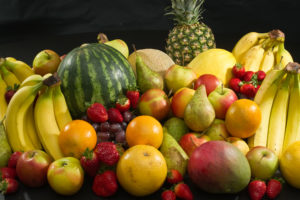 A recent study found that eating higher levels of foods with flavonoids (e.g. berries, apples, and tea) may lower the risk of later development of Alzheimer's disease and other age-related dementias.
A recent study found that eating higher levels of foods with flavonoids (e.g. berries, apples, and tea) may lower the risk of later development of Alzheimer's disease and other age-related dementias.
Since currently there are no effective drugs that prevent or actual medical treatments for dementia, it is great that what a person eats (the dietary pattern) long-term may be protective. Something we can do to lower our risk for Alzheimer's disease and other dementias!
Tufts University researchers followed 2801 persons (50 years and older) for 20 years and found that those with the lowest intake of flavonoid rich foods (especially 3 flavonoid classes: flavonols, anthocyanins, and flavonoid polymers) had a 20 to 40% higher chance of developing Alzheimer's disease and other dementias, when compared to those eating the most flavonoid rich foods. [Note: The lowest intake group averaged about 1 1/2 apples, but no berries or tea per month.]
Flavonoids are naturally occurring bioactive pigments, of which there are 7 types, that are found in plant-based foods. Some good sources of different types of flavonoids include berries & red wine (anthocyanin rich), onions & apples, pears (flavonol rich), citrus fruits and juices, teas, dark chocolate, parsley, celery,and soy products.
Eating a variety of fruits and vegetables appears to be best for health benefits. There is no one super-food. Other studies also find that the Mediterranean diet, which emphasizes fruits and vegetables (thus flavonoid rich), may reduce the risk of cognitive decline and dementia, including Alzheimer's disease.
Why are flavonoid containing foods protective, specifically "neuroprotective"? Studies suggest that they do the following: antioxidant effects, protect neurons from neurotoxins and combat neuroinflammation, and favorable changes in brain blood flow,
Excerpts from Science Daily: More berries, apples and tea may have protective benefits against Alzheimer's
Older adults who consumed small amounts of flavonoid-rich foods, such as berries, apples and tea, were two to four times more likely to develop Alzheimer's disease and related dementias over 20 years compared with people whose intake was higher, according to a new study led by scientists at the Jean Mayer USDA Human Nutrition Research Center on Aging (USDA HNRCA) at Tufts University.
The epidemiological study of 2,800 people aged 50 and older examined the long-term relationship between eating foods containing flavonoids and risk of Alzheimer's disease (AD) and Alzheimer's disease and related dementias (ADRD). While many studies have looked at associations between nutrition and dementias over short periods of time, the study published today in the American Journal of Clinical Nutrition looked at exposure over 20 years.
Flavonoids are natural substances found in plants, including fruits and vegetables such as pears, apples, berries, onions, and plant-based beverages like tea and wine. Flavonoids are associated with various health benefits, including reduced inflammation. Dark chocolate is another source of flavonoids.
The research team determined that low intake of three flavonoid types was linked to higher risk of dementia when compared to the highest intake. Specifically:
- Low intake of flavonols (apples, pears and tea) was associated with twice the risk of developing ADRD.
- Low intake of anthocyanins (blueberries, strawberries, and red wine) was associated with a four-fold risk of developing ADRD.
- Low intake of flavonoid polymers (apples, pears, and tea) was associated with twice the risk of developing ADRD.
The results were similar for AD.
The researchers analyzed six types of flavonoids and compared long-term intake levels with the number of AD and ADRD diagnoses later in life. They found that low intake (15th percentile or lower) of three flavonoid types was linked to higher risk of dementia when compared to the highest intake (greater than 60th percentile). Examples of the levels studied included:
- Low intake (15th percentile or lower) was equal to no berries (anthocyanins) per month, roughly one-and-a-half apples per month (flavonols), and no tea (flavonoid polymers).
- High intake (60th percentile or higher) was equal to roughly 7.5 cups of blueberries or strawberries (anthocyanins) per month, 8 apples and pears per month (flavonols), and 19 cups of tea per month (flavonoid polymers).
Jacques also said 50, the approximate age at which data was first analyzed for participants, is not too late to make positive dietary changes. "The risk of dementia really starts to increase over age 70, and the take home message is, when you are approaching 50 or just beyond, you should start thinking about a healthier diet if you haven't already," he said.
To measure long-term flavonoid intake, the research team used dietary questionnaires, filled out at medical exams approximately every four years by participants in the Framingham Heart Study, a largely Caucasian group of people who have been studied over several generations for risk factors of heart disease.
The participants were from the Offspring Cohort (children of the original participants), and the data came from exams 5 through 9. At the start of the study, the participants were free of AD and ADRD, with a valid food frequency questionnaire at baseline. Flavonoid intakes were updated at each exam to represent cumulative average intake across the five exam cycles.
